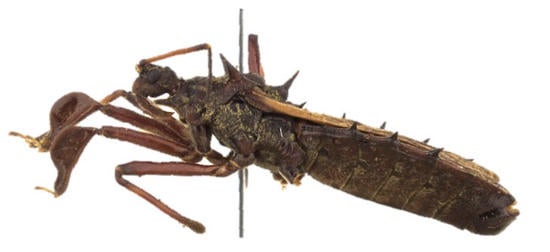Diagnosis and Specialized Morphology
Salyavatinae are sometimes referred to as termite-feeding assassin bugs. Most members of this subfamily are characterized by:
- small, somewhat globular head that is constricted behind compound eyes
- sometimes antennae appear 3-segments and inserted on prominent, anteriorly projecting tubercules
- moderately long and weakly curving labium
- sharp, slender spines on pronotum, scutellum, and abdomen
- fossula spongiosa present on fore and middle legs
- foretarsi 2-segmented and 3-segment on other legs
Taxonomic History
Taxonomic history for this subfamily is being reviewed.
Natural History/Biology
Salyavatinae is comprised of 16 circumtropical genera (Schuh & Slater 1995). Most species are nocturnal. In some species, nymphs possess sticky setae that is utilized in camouflaging with debris (Schuh & Slater 1995).
Check out revisions of the subfamily here!
References
Schuh, R.T., Slater, J.A. 1995. True Bugs of the World (Hemiptera: Heteroptera): Classification and Natural History. Comstock Pub. Associates, Ithaca. 336 pp.

